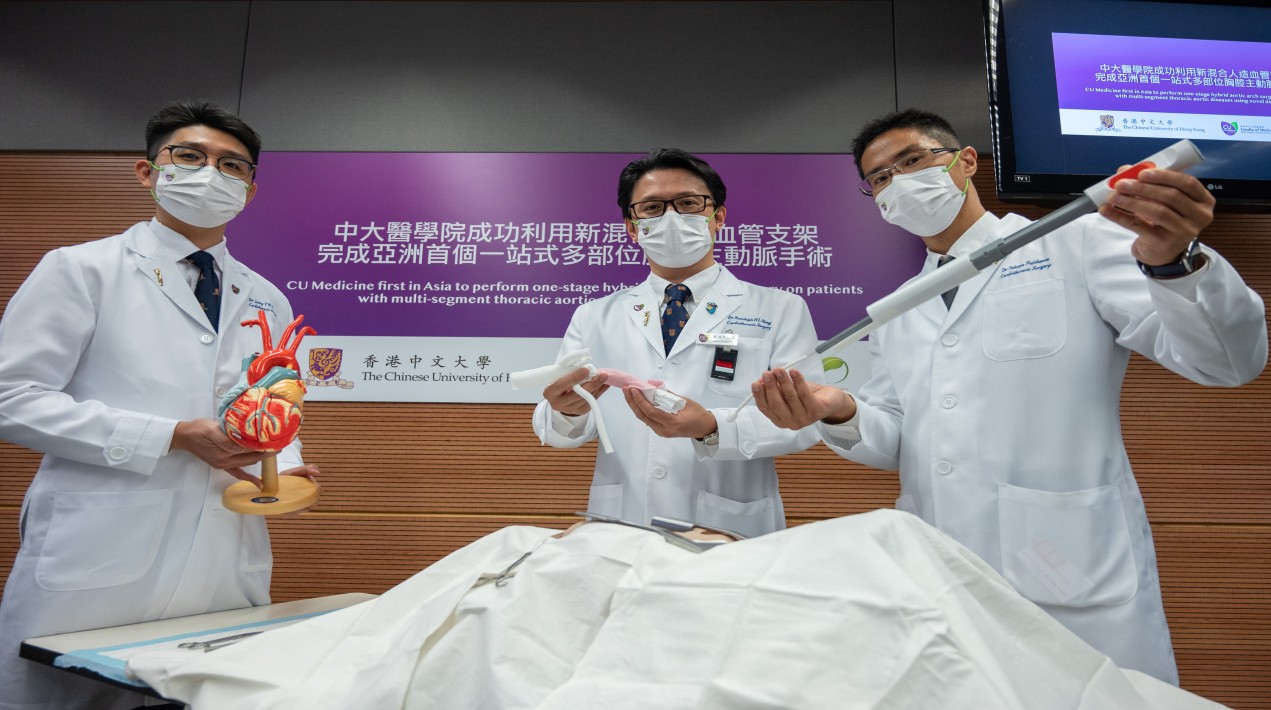
Thoracic aortic aneurysm (TAA) is common among hypertension patients and is one of the top leading causes of death in Hong Kong. Treatments for TAA may include surgical repair or removal of the aneurysm, or the insertion of a covered metallic stent to support the blood vessel and prevent rupture.
The Cardiothoracic Surgery team of The Chinese University of Hong Kong (CUHK)’s Faculty of Medicine (CU Medicine) has been taking a leading role in aortic arch surgery in Asia, providing a testing ground for the latest surgical devices in the field.
The team has, for the first time in Asia, performed one-stage hybrid aortic arch surgery on patients with multi-segment aortic diseases using a new E-vita® OPEN NEO device. So far, 25 patients have been treated and reported satisfactory outcomes. Results have been published on the Cardiothoracic Surgery Network and in the Journal of Cardiac Surgery.
TAA is the second most common aortic disease worldwide after atherosclerosis. It accounts for more than 1,400 hospital admissions and 300 deaths every year in Hong Kong. The CU Medicine team previously reported that the prevalence of TAA among Chinese hypertensive patients was 7.5%. TAA is defined as a permanent dilation of the aorta with an increase of over 50% in diameter relative to the diameter of the adjacent normal segment or with a diameter of 4.5cm or above.
The Clinical Assistant Professor (honorary) in the Division of Cardiothoracic Surgery of the Department of Surgery at CU Medicine, explained that aortic aneurysms are a silent killer – 95% of cases carry no symptoms prior to presentation of the lethal complications.
The University’s unit is seeing an increase in the number of aorta-related diseases from about 20 cases per year 10 years ago to currently about 100 cases per year, and there is an increasing incidence of patients aged 50 or below developing aortic dissection.
CU Medicine’s Cardiothoracic Surgery team has been a pioneer in aortic arch surgery in Asia. They introduced the first-of-its-kind TAR FET procedure with Thoraflex™ Device in August 2014 and published the results in an international journal in 2020.
In October 2020, the team also performed Asia’s first TAR FET procedure using the E-vita® OPEN NEO branched graft via a virtual proctoring platform during the COVID-19 pandemic. The new technology has been designed to prevent stent shortening after surgery and has various configurations to adapt to different aortic anatomies and diseases.
Dr Takuya Fujikawa, Clinical Assistant Professor (honorary) in the Division of Cardiothoracic Surgery of the Department of Surgery at CU Medicine, stated that the team has treated 25 patients who usually required multi-stage operations, converting them into a single-stage procedure, in the past two years. This was done using the E-vita® OPEN NEO TAR FET device.
Patients who have multiple segments of aortic aneurysm involving the ascending, arch and descending thoracic aorta, require multi-stage operations. Conventionally, the first stage is to replace the ascending aorta and the aortic arch, the patient will then need to have a second operation, either endovascular or open descending replacement to treat the aneurysm and avoid further dissection or rupture.
The advancement of the surgical graft allowed all these to be done in a single operation. This reduced the number of operations and a total hospital stay of patients and achieved 0% mortality with very few complications such as bleeding, stroke or spinal cord injury.
The CU Medicine team has performed more than 140 arch replacements in the past 10 years. In the initial phase of the adoption of the TAR FET procedure, it achieved operative mortality of 9%, which was already better than the international results.
Dr Fujikawa added that the team has proved virtual proctoring is a feasible approach to introducing new surgical devices, and that detailed pre-operative planning and training, well-executed intra-operative surgical procedure and careful post-operative monitoring are the keys to achieving and maintaining excellent clinical outcomes.
The training on the new device was performed solely via virtual proctoring amid the COVID-19 pandemic, which researchers described as an unprecedented challenge. Professor Randolph Wong Hung-leung, Professor and Chief in the Division of Cardiothoracic Surgery of the Department of Surgery at CU Medicine stated that one of the most effective ways is to introduce state-of-the-art devices from around the world.
Previously, surgeons travelled to overseas hospitals to receive training as the first stage, followed by on-site training by overseas proctors. However, after travel restrictions were imposed during the pandemic, CU Medicine adopted an innovative approach of using a virtual proctoring platform to conduct procedural planning and intra-operative coaching by a proctor from Germany. The procedure went smoothly, with a good patient outcome.
















